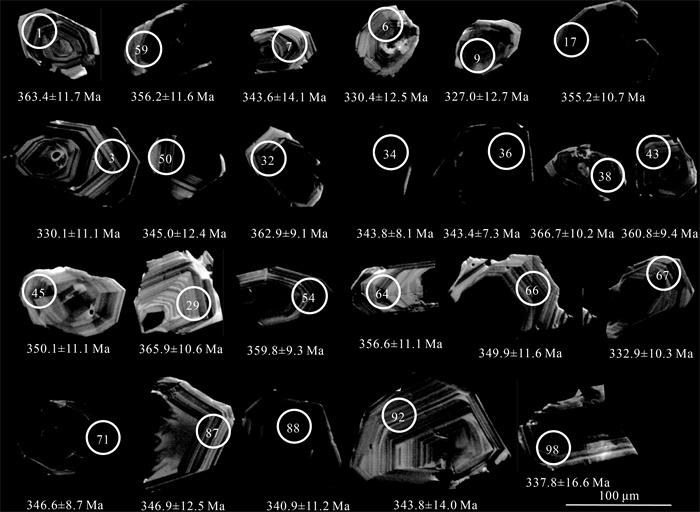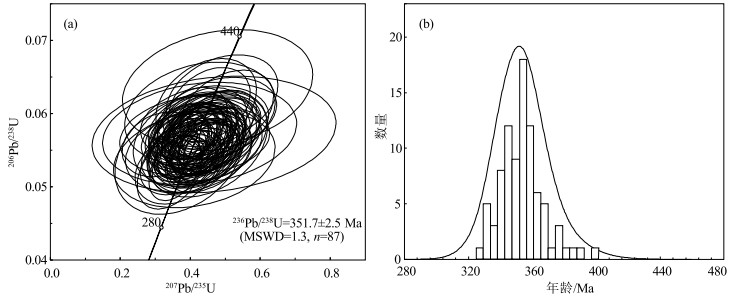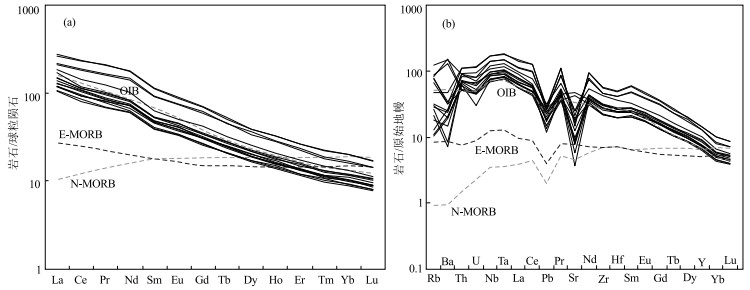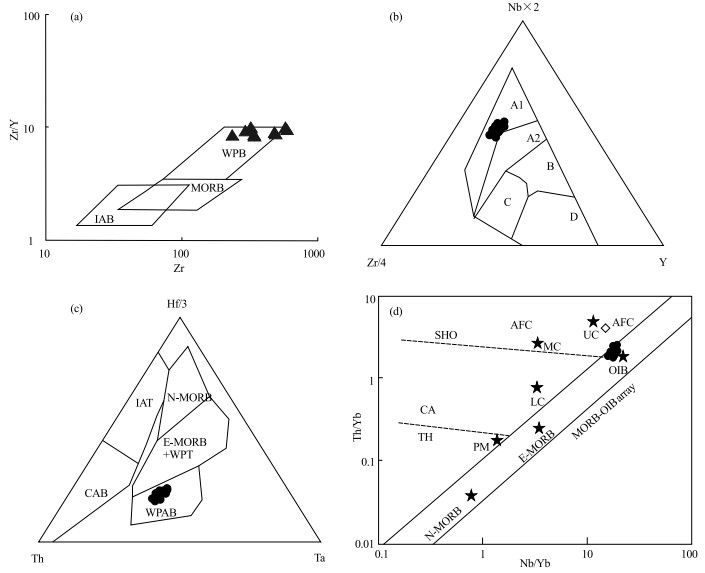The age and tectonic environment of Carboniferous volcanic-sedimentary strata in Changning-Menglian zone, Western Yunnan Province
-
摘要:
昌宁-孟连结合带内大面积出露石炭纪火山-沉积地层,对其时代的精确厘定及古构造环境的识别,有助于认识和恢复昌宁-孟连结合带乃至东古特提斯洋演化。通过详细的野外地质调查与剖面测制,查明玄武岩与碳酸盐岩之间为整合接触关系。对碳酸盐岩开展了详细的微相分析,识别出4种微相类型,分别为颗粒生屑灰岩(MF1)、似球粒泥粒生屑灰岩(MF2)、鲕粒灰岩(MF3)和含珊瑚碎屑礁灰岩(MF4),主体形成于热带-亚热带较温暖的古气候背景,代表了浅水高能环境。对碳酸盐岩与玄武岩之间的凝灰岩夹层开展锆石U-Pb定年研究,获得206Pb/238U年龄加权平均值为351.7±2.5 Ma,表明玄武岩的喷发时代为早石炭世。该套火山-沉积地层岩石组合包括具有OIB型地球化学特征的玄武岩、礁灰岩、塌积砾岩、凝灰岩等,将其构造环境厘定为洋岛-海山。该洋岛-海山是三江造山带洋壳残片的重要组成部分,记录了古特提斯洋盆构造演化及造山带形成过程的重要信息。
Abstract:A large area of Carboniferous volcanic-sedimentary strata is exposed in the Changning-Menglian junction.The precise determination of its age and the identification of the paleo-tectonic environment are of great significance for understanding and restoration of Changning-Menglian zone and evolution of the Eastern Paleotethys Ocean.The detailed field geological survey and profile surveying indicate that the contact between basalt and carbonate rock is conformity.A detailed microfacies analysis was carried out on carbonate rocks, and four types of microfacies were identified, granular bioclastic limestone (MF1), spherulitic mud particles bioclastic limestone (MF2), oolitic limestone (MF3) and coral clastic reef limestone (MF4), indicating that the main carbonate rock was formed in a shallow-water high-energy environment under a warmer tropical-subtropical palaeoclimate background.Zircon U-Pb dating of the tuff interbeded between carbonate rock and basalt yields the average age of 351.7±2.5 Ma, indicating that the eruption of basalt was in the Early Carboniferous.This set of volcanic-sedimentary rocks include basalt, reef limestone, tuff, etc.with OIB-type geochemical characteristics, and its tectonic environment is defined as ocean island-seamount, which is an important part of oceanic crust fragments in the Sanjiang orogen and records important information about the tectonic evolution of the Paleo-Tethys oceanic basin and the formation process of the orogenic belt.
-
致谢: 笔者在中国地质调查局成都地质调查中心学习期间多次受到潘桂棠先生悉心指导,有幸见识到老一辈地质工作者艰苦奋斗、不屈不挠、求真务实的科学精神。潘老师80岁高龄仍继续为祖国的地质事业发光发热,给年轻一辈树立了崇高榜样,祝愿潘老师健康长寿。参与野外工作的还有中国地质调查局成都地质调查中心李建忠研究员、彭智敏高级工程师、成都理工大学在读硕士研究生尤廷海和裴洋;锆石U-Pb定年在中国地质调查局成都地质调查中心胡志中高级工程师帮助下完成,在此一并表示衷心的感谢。
-
图 6 平掌组玄武岩构造环境判别图解
a—Zr-Zr/Y图解[52]; b—Nb×2-Zr/4-Y图解[53];c—Hf/3-Th-Ta图解[54];d—Nb/Yb-Th/Yb图解[55];WPB—板内玄武岩;IAB—岛弧玄武岩;MORB—洋中脊玄武岩;A1+A2—板内碱性玄武岩;A2+C—板内拉斑玄武岩;B—P型MORB;D—N-MORB;C+D—火山弧玄武岩;CAB—钙碱性玄武岩;WPAB—板内碱性玄武岩;N-MORB—亏损型洋中脊玄武岩;E-MORB—富集型洋中脊玄武岩;Th—拉斑质;CA—钙碱质;
SHO—钾玄质;PM—原始地幔;LC—平均下地壳;UC—上地壳;MC—中地壳Figure 6. Tectonic setting discrimination of the basalts from Pingzhang Formation
表 1 平掌组玄武岩主量、微量和稀土元素组成
Table 1 Major, trace element and REE compositions of the basalts from Pingzhang Formation
样品名 D0004- H1 D0004- H2 D0005- H1 D0005- H2 D0005- H3 D0005- H4 D0005- H5 D0005- H6 PM101- 1H1 PM101- 3H1 PM101- 4H1 PM101- 4H2 PM102- 1H1 PM102- 2H2 SiO2 42.92 45.7 45.61 45.67 43.54 41.42 43.67 42.55 42.88 43.25 43.28 43.59 45.57 45.8 Al2O3 15.45 15.33 13.13 13.17 10.8 11.66 12.88 12.42 13.39 11.46 12.89 13.06 16.23 16.36 CaO 8.24 9.29 6.29 6.45 10.29 9.2 7.58 8.71 7.72 8.92 10.05 8.5 7.19 7.54 MgO 3.65 5.58 6.46 5.4 10.85 13.04 8.56 9.89 7.24 9.01 9.66 7.86 4.04 3.64 K2O 1.36 0.6 0.32 0.36 0.18 0.28 1.73 0.67 2.42 1.19 1.67 1.72 1.77 1.36 Na2O 4.08 4.51 4.44 4.13 3.2 1.7 3.49 3.96 2.32 1.85 2.12 1.68 3.95 4.54 TiO2 3.8 3.74 3.5 3.62 2.73 3.12 3.39 3.11 4.08 4.06 3.51 3.26 3.02 3 P2O5 1.77 1.66 0.56 0.61 0.51 0.56 0.59 0.55 0.86 0.59 0.46 0.45 1.74 1.73 MnO 0.2 0.23 0.1 0.099 0.19 0.21 0.15 0.18 0.12 0.11 0.15 0.13 0.22 0.23 烧失量 3.72 3.94 5.5 6.76 5.02 5.14 4.37 5.25 5.36 7 3.85 7.69 4.3 3.88 TFe2O3 14.65 9.27 14.01 13.63 12.57 13.52 13.48 12.62 13.42 12.45 12.12 11.94 11.85 11.81 Li 11.9 19.1 5.24 5.65 7.60 8.65 10.9 12.8 9.04 10.6 8.75 11.9 7.69 6.99 Be 2.63 2.73 1.49 1.94 1.55 1.10 1.47 1.75 1.81 1.32 1.32 1.36 3.35 4.02 Sc 16.7 16.0 28.0 28.7 26.7 27.8 27.8 26.0 26.8 32.1 33.1 33.5 11.2 11.3 V 225 177 281 311 176 295 150 150 234 311 328 325 123 132 Cr 8.12 6.58 427 437 637 535 445 413 251 630 466 470 5.43 3.63 Co 26.0 28.8 47.2 45.8 54.7 59.8 56.1 58.0 44.8 54.7 52.1 51.9 16.7 16.8 Ni 15.4 15.1 280 256 321 320 287 274 148 322 227 247 6.72 5.90 Cu 12.0 12.9 76.7 89.5 20.0 144 16.2 21.4 48.6 61.3 42.1 38.0 4.70 5.46 Zn 138 156 115 114 101 109 110 114 127 111 95.0 98.5 148 141 Ga 29.0 26.0 20.8 21.8 17.0 19.9 20.8 21.0 22.2 20.2 19.3 20.1 28.1 27.4 Rb 19.0 7.82 12.7 15.6 6.29 10.9 45.9 18.1 73.1 46.3 49.2 52.1 39.5 28.5 Sr 429 504 177 163 362 937 156 249 501 117 850 196 296 327 Y 55.9 54.6 36.1 39.2 27.1 31.0 32.3 31.4 43.2 32.8 28.7 28.7 61.9 61.9 Zr 488 485 324 335 233 289 317 293 451 286 229 227 591 588 Nb 93.4 92.0 63.2 64.0 49.0 58.5 59.4 55.4 78.0 49.5 49.2 45.1 111 111 Sn 3.40 3.26 1.93 2.62 1.79 2.22 2.08 1.69 2.41 2.07 1.85 1.66 3.94 3.93 Cs 0.66 0.37 0.67 0.42 0.33 0.36 1.88 1.30 1.53 1.06 0.86 2.17 0.53 0.43 Ba 163 176 47.2 55.3 127 96.3 227 129 969 208 994 852 212 315 La 74.2 71.9 50.4 51.0 40.6 43.7 47.6 44.2 63.0 40.0 36.2 35.8 95.3 91.5 Ce 168 163 101 99.5 84.1 95.0 96.6 91.7 128 82.0 74.8 71.0 212 209 Pr 22.3 21.5 12.7 13.1 10.2 11.4 11.8 11.2 16.5 10.7 9.16 8.99 27.8 28.2 Nd 97.0 92.9 52.3 53.8 41.3 47.1 48.8 47.5 66.9 47.1 39.7 39.0 119 117 Sm 19.7 19.3 11.1 11.3 8.58 9.69 10.1 9.86 13.4 10.3 8.29 8.14 24.3 23.9 Eu 6.01 5.92 3.39 3.62 2.70 3.05 3.27 3.01 4.02 3.22 2.66 2.63 7.23 6.93 Gd 17.3 16.6 9.46 9.56 7.25 8.65 8.42 8.45 11.7 8.85 7.43 7.12 20.0 19.4 Tb 2.27 2.31 1.34 1.39 1.04 1.22 1.26 1.19 1.61 1.25 1.04 1.05 2.66 2.55 Dy 12.6 11.6 7.47 7.70 5.69 6.53 6.95 6.47 8.74 6.92 5.80 5.86 13.4 13.5 Ho 2.18 2.17 1.34 1.44 1.05 1.20 1.23 1.18 1.59 1.30 1.08 1.14 2.50 2.49 Er 5.27 5.06 3.47 3.56 2.57 3.03 3.08 3.00 3.86 3.03 2.67 2.67 5.90 5.96 Tm 0.65 0.62 0.43 0.44 0.33 0.37 0.39 0.40 0.51 0.39 0.37 0.35 0.77 0.77 Yb 3.73 3.56 2.54 2.65 1.94 2.23 2.42 2.28 2.92 2.23 2.00 2.03 4.48 4.44 Lu 0.49 0.49 0.35 0.36 0.26 0.31 0.32 0.30 0.38 0.29 0.27 0.27 0.58 0.58 Hf 11.7 11.6 7.62 7.93 5.63 6.88 7.45 6.97 10.2 6.96 5.62 5.62 14.0 13.9 Ta 5.53 5.46 3.81 3.84 3.04 3.45 3.65 3.31 4.83 3.07 2.94 2.79 6.60 6.79 Tl 0.036 0.013 0.021 0.016 0.016 0.020 0.067 0.037 0.045 0.036 0.039 0.051 0.049 0.027 Pb 3.82 3.97 3.06 2.70 3.38 3.67 2.60 1.80 4.78 2.05 2.82 2.26 4.07 4.34 Th 7.27 7.13 5.63 5.74 4.89 5.45 5.41 5.12 7.16 4.04 4.18 4.06 8.82 8.79 U 1.92 1.64 1.21 1.30 0.61 1.08 1.34 0.93 1.45 0.93 1.02 0.90 2.28 2.34 ∑REE 431.29 416.54 257.44 259.51 207.63 233.49 242.21 230.76 322.64 217.45 191.48 186.04 535.04 526.19 (La/Yb)N 13.52 13.71 13.49 13.06 14.26 13.30 13.37 13.16 14.66 12.19 12.29 11.99 14.44 14.00 δEu 1.03 1.02 1.01 0.97 0.99 1.01 0.95 1.02 1.05 1.00 0.99 0.97 1.03 1.05 注:主量元素含量单位为%,微量、稀土元素含量单位为10-6 -
S, engör A M C. The Cimmeride orogenic system and the tectonics of Eurasia[M]. Geological Society of America Special Papers, 1984: 1-74.
Sengör A M C, Natal'I B A, Burtman V S. Evolution of the Altaid tectonic collage and Palaeozoic crustal growth in Eurasia[J]. Nature, 1993, 364(6435): 299-307. doi: 10.1038/364299a0
Dewey J F, Sun Y Y. The tectonic evolution of the Tibetan Plateau[J]. Philosophical Transactions of the Royal Society B Biological Sciences, 1988, 327: 379-413. http://www.onacademic.com/detail/journal_1000036514939310_4dc2.html
从柏林, 吴根耀, 张旗. 中国滇西地区古特提斯演化的岩石记录[C]//IGCP第321项中国工作组编. 亚洲的增生. 北京: 地震出版社, 1993: 65-68. 潘桂棠, 徐强, 侯增谦, 等. 西南"三江"多岛弧造山过程成矿系统与资源评价[M]. 北京: 地质出版社, 2003: 1-150. Metcalfe I. Late Palaeozoic and Mesozoic tectonic and palaeogeographical evolution of SE Asia[M]. Geological Society, London, Special Publications, 2009, 315: 7-23.
许志琴, 王勤, 李忠海, 等. 印度-亚洲碰撞: 从挤压到走滑的构造转换[J]. 地质学报, 2016, 90(1): 1-23. https://www.cnki.com.cn/Article/CJFDTOTAL-DZXE201601001.htm Wang B D, Wang L Q, Pan G T, et al. U-Pb zircon dating of Early Paleozoic gabbro from the Nantinghe ophiolite in the Changning-Menglian Suture Zone and its geological implication[J]. Chinese Science Bulletin, 2013, 58(8): 920-930. doi: 10.1007/s11434-012-5481-8
聂小妹. 滇西南及泰国北部古生代早中期特提斯演化研究[D]. 中国地质大学博士学位论文, 2015. 王冬兵, 罗亮, 唐渊, 等. 昌宁-孟连结合带牛井山早古生代达克岩锆石U-Pb年龄、岩石成因及其地质意义[J]. 岩石学报, 2016, 32(8): 2317-2329. https://www.cnki.com.cn/Article/CJFDTOTAL-YSXB201608006.htm 潘桂棠, 肖庆辉, 张克信, 等. 大陆中洋壳俯冲增生杂岩带特征与识别的重大科学意义[J]. 地球科学, 2019, 44(5): 1544-1561. https://www.cnki.com.cn/Article/CJFDTOTAL-DQKX201905012.htm 王保弟, 王立全, 王冬兵, 等. 三江昌宁-孟连带原-古特提斯构造演化[J]. 地球科学, 2018, 43(8): 2527-2550. https://www.cnki.com.cn/Article/CJFDTOTAL-DQKX201808001.htm 王冬兵, 罗亮, 唐渊, 等. 昌宁-孟连结合带斜长角闪岩锆石U-Pb年龄、地球化学特征及其地质意义[J]. 沉积与特提斯地质, 2017, 37(4): 17-28. doi: 10.3969/j.issn.1009-3850.2017.04.004 李静. 云南省双江县石炭纪牛井山蛇绿混杂岩的岩石学研究[D]. 昆明理工大学硕士学位论文, 2003. Fan W M, Wang Y J, Zhang Y H, et al. Paleotethyan subduction process revealed from Triassic blueschists in the Lancang tectonic belt of Southwest China[J]. Tectonophysics, 2015, 662: 95-108. doi: 10.1016/j.tecto.2014.12.021
李静, 孙载波, 徐桂香, 等. 滇西双江县勐库地区榴闪岩的发现与厘定[J]. 矿物学报, 2015, 35(4): 421-424. https://www.cnki.com.cn/Article/CJFDTOTAL-KWXB201504001.htm 王舫, 刘福来, 冀磊, 等. 澜沧江杂岩带小黑江-上允地区蓝片岩的成因及变质演化[J]. 岩石矿物学杂志, 2016, 35(5): 804-820. doi: 10.3969/j.issn.1000-6524.2016.05.005 Wang F, Liu F L, Schertl, et al. Paleo-Tethyan tectonic evolution of Lancangjiang Metamorphic Complex: Evidence from SHRIMP U-Pb zircon dating and 40Ar/39Ar isotope geochronology of blueschists in Xiaoheijiang-Xiayun area, Southeastern Tibetan Plateau[J]. Gondwana Research, 2019, 65: 142-155. doi: 10.1016/j.gr.2018.08.007
Wang H N, Liu F L, Santosh M, et al. Subduction Eosion Asociated with Paleo-Tethys Closure: Deep Subduction of Sediments and High Pressure Metamorphism in the SE Tibetan Plateau[J]. Gondwana Research, 2020: 82: 171-192. doi: 10.1016/j.gr.2020.01.001
彭智敏, 王国之, 王保弟, 等. 云南邦丙澜沧岩群中发现蓝闪石榴辉岩[J]. 成都理工大学学报(自然科学版), 2019, 46(5): 639-640. doi: 10.3969/j.issn.1671-9727.2019.05.14 Zhao T Y, Feng Q L, Metcalfe I, et al. Detrital zircon U-Pb-Hf isotopes and provenance of Late Neoproterozoic and Early Paleozoic sediments of the Simao and Baoshan blocks, SW China: Implications for Proto-Tethys and Paleo-Tethys evolution and Gondwana reconstruction[J]. Gondwana Research, 2017, 51: 193-208. doi: 10.1016/j.gr.2017.07.012
赵林涛, 李三忠, 吕勇, 等. 滇西允沟岩组碎屑锆石年龄谱对相关地块亲缘性的约束[J]. 岩石学报, 2019, 35(9): 2911-2925. https://www.cnki.com.cn/Article/CJFDTOTAL-YSXB201909019.htm 周美玲, 夏小平, 彭头平, 等. 滇西保山地块早古生代碎屑锆石U-Pb-Hf同位素研究及其对冈瓦纳大陆重建的制约[J]. 岩石学报, 2020, 36(2): 469-483 https://www.cnki.com.cn/Article/CJFDTOTAL-YSXB202002009.htm 方宗杰, 周志澄, 林敏基. 从地层学的角度探讨昌宁-孟连缝合带的若干问题[J]. 地层学杂志, 1992, 16(4): 292-303 https://www.cnki.com.cn/Article/CJFDTOTAL-DCXZ199204008.htm 吴根耀. 云南澜沧老厂-拉巴的互冲推覆构造[J]. 科学通报, 1991, 1: 44-46. https://www.cnki.com.cn/Article/CJFDTOTAL-KXTB199101013.htm 吴根耀. 滇西昌宁-孟连地区依柳组、平掌组地层初议[J]. 地层学杂志, 1993, 17(4): 302-309. https://www.cnki.com.cn/Article/CJFDTOTAL-DCXZ199304008.htm 张海清, 刘本培, 方念乔. 滇西南古特提斯石炭纪海山碳酸盐台地的层序地层学研究[J]. 沉积学报, 1997, 15(4): 18-23. https://www.cnki.com.cn/Article/CJFDTOTAL-CJXB704.003.htm 张海清, 孙晓猛, 陈先兵. 洋岛、海山碳酸盐岩的沉积特征及其古地理意义[J]. 地质科技情报, 1997, 16(1): 29-33. https://www.cnki.com.cn/Article/CJFDTOTAL-DZKQ701.005.htm 刘本培, 冯庆来, 方念乔, 等. 滇西南昌宁-孟连带和澜沧江带古特提斯多岛洋构造演化[J]. 地球科学——中国地质大学学报, 1993, 18(5): 529-539. https://www.cnki.com.cn/Article/CJFDTOTAL-DQKX199305000.htm 潘桂棠, 肖庆辉, 陆松年, 等. 中国大地构造单元划分[J]. 中国地质, 2009, 36(1): 1-28. https://www.cnki.com.cn/Article/CJFDTOTAL-DIZI200901004.htm 王冬兵, 罗亮, 王保弟, 等. 滇西澜沧江构造带景谷地区团梁子岩组的时代与构造属性[J]. 地球科学, 2018, 43(8): 2551-2570. https://www.cnki.com.cn/Article/CJFDTOTAL-DQKX201808002.htm 赵靖, 钟大赉, 王毅. 滇西澜沧变质带的变形序列与变质作用初步研究[J]. 地质科学, 1994, 29(4): 366-372. https://www.cnki.com.cn/Article/CJFDTOTAL-DZKX404.005.htm 赵靖, 钟大赉, 王毅. 滇西澜沧变质带变质作用和变形作用的关系[J]. 岩石学报, 1994, 10(1): 27-40. doi: 10.3321/j.issn:1000-0569.1994.01.003 宋仁奎, 应育浦, 叶大年. 滇西南澜沧群多硅白云母的多型和化学成分特征及其意义[J]. 岩石学报, 1997, 13(2): 152-161. doi: 10.3321/j.issn:1000-0569.1997.02.003 彭智敏, 张缉, 关俊雷, 等. 滇西"三江"地区临沧花岗岩基早-中奥陶世花岗质片麻岩的发现及其意义[J]. 地球科学, 2018, 43(8): 2571-2585. https://www.cnki.com.cn/Article/CJFDTOTAL-DQKX201808003.htm 罗亮, 谢韬, 王冬兵, 等. 昌宁-孟连结合带中三叠世含放射虫硅质岩地层的古特提斯意义[J]. 地球科学, 2020, 45(8): 3014-3027. https://www.cnki.com.cn/Article/CJFDTOTAL-DQKX202008021.htm Yang F, Sun J G, Wang Y, et al. Geology, geochronology and Geochemistry of Weilasituo Sn-Polymetallic deposit in Inner Mongolia, China[J]. Minerals, 2019, 9(2): 104. doi: 10.3390/min9020104
Liu Y S, Gao S, Hu Z C, et al. Continental and oceanic crust recycling-induced melt-peridotite interactions in the Trans-North China Orogen: U-Pb dating, Hf isotopes and trace elements in zircons from mantle xenoliths[J]. Journal of Petrology, 2010, 51: 537-571. doi: 10.1093/petrology/egp082
Ludwig K.R. ISOPLOT 3.00: A Geochronological Toolkit for Microsoft Excel[M]. Berkeley, Califomia: Berkeley Geochronology Center, 2003.
冯庆来, 刘本培. 滇西南昌宁-孟连构造带火山岩地层学研究[J]. 现代地质, 1993, 7(4): 402-409. https://www.cnki.com.cn/Article/CJFDTOTAL-XDDZ199304004.htm 张远志, 张定辉, 刘世荣, 等. 云南省岩石地层[M]. 武汉: 中国地质大学出版社, 1996: 1-367. 王义昭. 滇西昌宁- 孟连带地质构造特征及构造环境分析[J]. 特提斯地质, 1997, 21: 31-55. https://www.cnki.com.cn/Article/CJFDTOTAL-TTSD721.002.htm 刘本培. 被动大陆边缘沉积[C]//钟大赉等. 滇川西部古特提斯造山带. 北京: 科学出版社, 1998: 76-91. 彭寿增. 试论澜沧含银铅锌矿带的成矿地质条件[J]. 云南地质, 1884, 3(2): 124-130. https://www.cnki.com.cn/Article/CJFDTOTAL-YNZD198402002.htm 方宗杰, 周志澄, 郭震宇, 等. 滇西南石炭纪平掌组火山岩与鱼塘寨组的接触关系[J]. 地层学杂志, 1999, 23(4): 257-262. https://www.cnki.com.cn/Article/CJFDTOTAL-DCXZ199904002.htm 田力, 童金南, 孙冬英, 等. 江西乐平沿沟二叠纪-三叠纪过渡期沉积微相演变及其对灭绝事件的响应[J]. 中国科学: 地球科学, 2014, 44(10): 2247-2261. https://www.cnki.com.cn/Article/CJFDTOTAL-JDXK201410013.htm Flügel E. Microfacie of Carbonate Rocks: Analysis, Interpretation and Application[M]. Berlin-Heidelberg: Springer-Verlag, 2004: 1-976.
McDonough W F, Sun S S. The Composition of the Earth[J]. Chemical Geology, 1995, 120(3/4): 223-253. doi: 10.1016/0009-2541(94)00140-4
Sun S S, McDonough W F. Chemical and isotopic systematics of oceanic basalts; implications for mantle composition and processes[J]. Geological Society Special Publications, 1989, 42: 313-345. doi: 10.1144/GSL.SP.1989.042.01.19
赖绍聪, 秦江锋, 李学军, 等. 昌宁-孟连缝合带乌木龙-铜厂街洋岛型火山岩地球化学特征及其大地构造意义[J]. 地学前缘, 2010, 17(3): 44-52. https://www.cnki.com.cn/Article/CJFDTOTAL-DXQY201003006.htm 杜晓飞, 程文斌, 李葆华, 等. 藏南柯月玄武岩地球化学特征及构造环境判别[J]. 新疆有色金属, 2020, 43(6): 84-90. https://www.cnki.com.cn/Article/CJFDTOTAL-XJYS202006030.htm Pearce J A, Norry M J. Petrogenetic Implications of Ti, Zr, Y, and Nb Variations in Volcanic Rocks[J]. Contributions to Mineralogy and Petrology, 1979, 69: 33-47. doi: 10.1007/BF00375192
Meschede M. A method of discriminating between different types of mid-ocean ridge basalts and continental tholeiites with the Nb-Zr-Y diagram[J]. Chemical Geology, 1986, (56): 207-218. http://www.onacademic.com/detail/journal_1000035296655110_4aed.html
Wood D A. Avariably veined suboceanic uppermantle-genetic significance for mid-ocean ridge basalts from geochemical evidence[J]. Geology, 1979, 7: 499-503 doi: 10.1130/0091-7613(1979)7<499:AVVSUM>2.0.CO;2
Pearce J A. Geochemical fingerprinting of oceanic basalts with applications to ophiolite classification and the search for Archean oceanic crust[J]. Lithos, 2008, 100: 14-48. doi: 10.1016/j.lithos.2007.06.016
冯庆来, 崔新省, 刘本培. 滇西澜沧老厂晚二叠世双壳动物群的发现及其生物区系特征[J]. 地球科学, 1992, (5): 512-520, 627-628. https://www.cnki.com.cn/Article/CJFDTOTAL-DQKX199205004.htm 胡祥昭, 陈惜华, 匡立新. 昌宁-孟连火山岩带玄武岩的岩石学及地球化学[J]. 中南矿冶学院学报, 1994, 25(5): 560-564. https://www.cnki.com.cn/Article/CJFDTOTAL-ZNGD199405007.htm 杨开辉, 莫宣学. 滇西南晚古生代火山岩与裂谷作用及区域构造演化[J]. 岩石矿物学杂志, 1993, 12(4): 297-311. https://www.cnki.com.cn/Article/CJFDTOTAL-YSKW199304002.htm 张旗, 李达周, 张魁武. 云南省云县铜厂街蛇绿混杂岩的初步研究[J]. 岩石学报, 1985, 1(3): 1-14. doi: 10.3321/j.issn:1000-0569.1985.03.001 李达周, 张旗, 张魁武. 青藏高原研究, 横断山考察专辑(二)[M]. 北京: 北京科学技术出版社, 1986: 137-145. 范建军, 李才, 牛耀龄, 等. 造山带板内洋岛-海山残片的识别及地质意义[J]. 地球科学, 2021, 46(2): 381-404. https://www.cnki.com.cn/Article/CJFDTOTAL-DQKX202102001.htm 付长磊, 闫臻, 王秉璋, 等. 造山带中古海山残片的识别——以拉脊山缝合带青沙山和东沟地质填图为例[J]. 地质通报, 2021, 40(1): 31-40. http://dzhtb.cgs.cn/gbc/ch/reader/view_abstract.aspx?file_no=20210104&flag=1 袁四化, 潘桂棠, 任飞, 等. 洋岛-海山研究进展及其对于重建洋板块的意义[J]. 地球科学, 2020, 45(8): 2826-2845. https://www.cnki.com.cn/Article/CJFDTOTAL-DQKX202008005.htm 云南省地质矿产局. 1∶25万临沧、滚龙幅(国内部分) 区域地质调查报告. 2003.




 下载:
下载:





